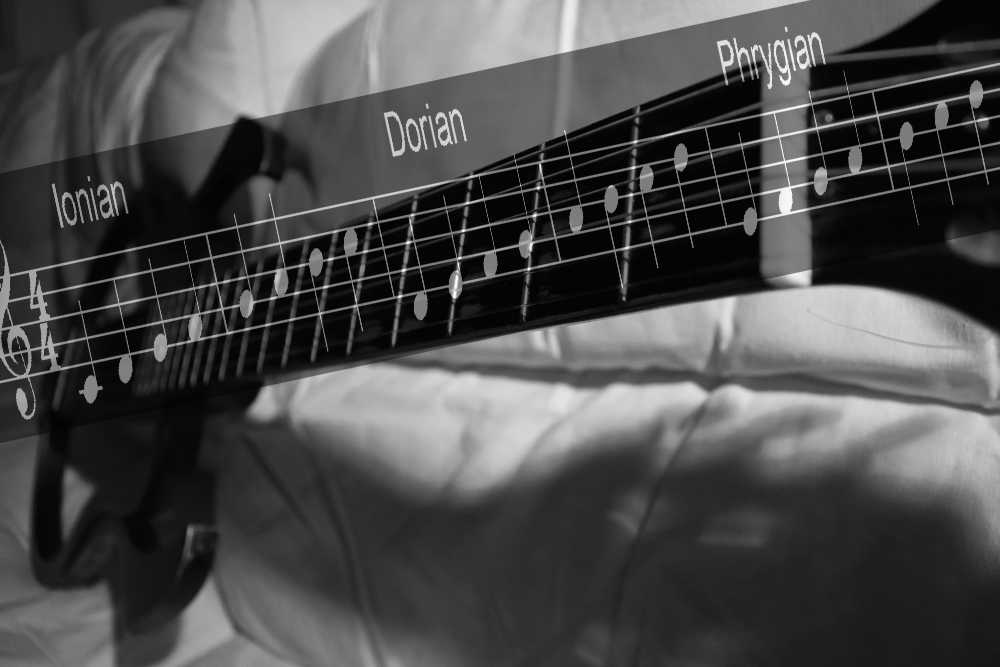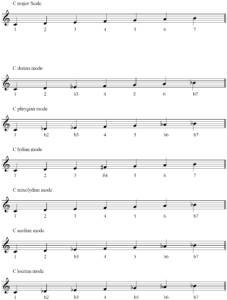
Modes Made Manageable
This post is the beginning of a series on digging into the major scale modes and their sound. It will focus on understanding the theory and applying it to the fretboard and then move onto getting the sound into your ear so that it is instantly recognizable: A.K.A ear training.
This post will give a quick over view of the major scale theory, and by quick we mean quick (check out a more in depth post on the major scale here). Its main thrust is to introduce two different way of thinking about modes and applying them.
Modes: what are they?
A mode is just a scale! Nothing more nothing less! But to be more specific it is better to describe it as a scale within a scale. There are seven modes that can be deduced from the major scale and they have names that come from yea olden days in Greece and their tribes.
So we get:
- 1 – Ionian Mode (major scale – mother scale)
- 2 – Dorian Mode
- 3 – Phrygian Mode
- 4 – Lydian Mode
- 5 – Mixolydian Mode
- 6 – Aeolian Mode
- 7 – Locrian Mode
Think of the major scale as the mother scale, and as with all scales the spaces or intervals between each note truly represent that scales character/sound. In this case its Julie Andrews and Doe a deer…(Yes that song from the Sound of Music. A fantastic way to get the mother scale (major scale) into your aural memory bank!)
And if we just rearrange the notes so that their relationships, and by relationships I mean spaces between each note, alter, we get modes. Or a scale within a scale.
Eg: So…C major is the mother scale, if we start from D and play up to D, all still in C major, we get a mode called D Dorian.
Nothing changes we are still in C major, all we did was a start the scale from another note within the mother scale. Notice the scale degree numbers under the dorian mode, they begin again at 1 as it is a new mode/scale. However peering above we can see they are still C major just rearranged to begin at degree 2 – D; hence – D dorian.
We can do this “scale within a scale” construction with anything, pentatonics, heptonics, Kumoi et.al. Once you understand the logic of it anything can be rearranged to form a mode.
2 Methods for Thinking
There are two ways of constructing modes: derivative and parallel. These are just methods that you can use for building, thinking or forming these modes. Be warned they are theoretical, a better more practical method will be outlined in part two of these articles.
Derivative Construction
This is essential modes built with the method described above, and importantly is
7 modes from 7 notes.
Or the modes of the C major scale. See below for the full C major scale and the modes that are derived from it.

Notice how the notes have no alterations to them (b or #) they are just rearranged into different starting notes, 1, ,2 ,3 etc.
Parallel Construction
This is essential modes built with the knowledge of the notes and their relationships to each other, and importantly is
7 modes from 1 notes.
Or all the modes of which begin on a C.

Notice how these modes are all built on the note C, and have lots of alterations (b or #).
Being able to understand both methods is essential to building modes. So that you should be able to say C lydian is mode 4 of the G major scale and it is also a major scale that has a #4.
This knowledge should be in your brain and at least part way understood for the next installation of Modes Made Manageable. Here we we rearrange the modes into a practical context and place it on the fretboard. They will also dovetail nicely with the CAGED system lessons which begin with this first post: CAGED Part 1. These lessons will be available as a free pdf booklet to download soon.



